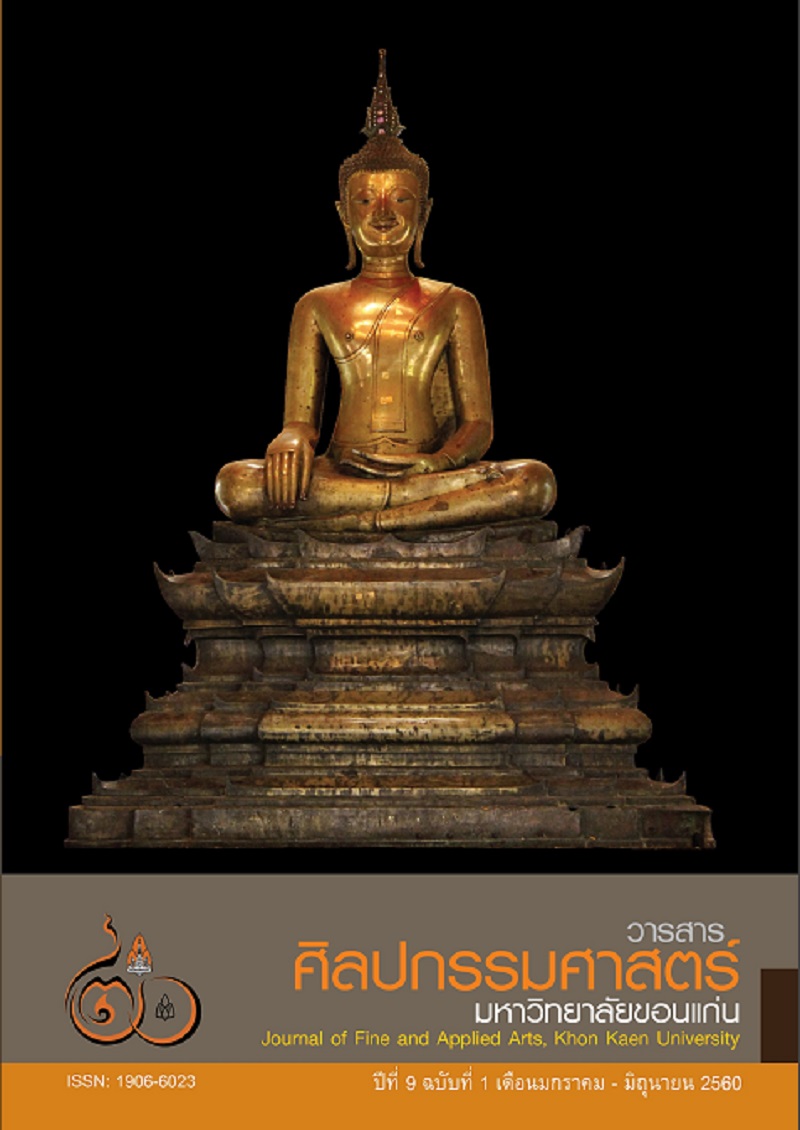ความเชื่อและพิธีกรรมของชุมชนต่อ ปราสาทวัดพู แขวงจำปาสัก สปป.ลาว BELIEFS AND RITES OF COMMUNITY ON WATPHU,CHAMPASAK, LAO PDR.
Main Article Content
Abstract
การวิจัยนี้ผู้วิจัยได้ทำการศึกษาความเชื่อและพิธีกรรมของชุมชนต่อ ปราสาทวัดพู แขวงจำปาสัก สปป.ลาว ผู้วิจัยมีวัตถุประสงค์เพื่อศึกษาประวัติความเป็นมาและสภาพปัจจุบันปราสาทวัดพู อีกทั้งความเชื่อต่อปราสาทวัดพูในอดีต จนไปถึงความเชื่อและพิธีกรรมชุมชนต่อปราสาทวัดพู แขวงจำปาสัก สปป.ลาวในปัจจุบัน ซึ่งในการศึกษาวิจัยครั้งนี้เป็นการศึกษาข้อมูลทั้งจากเอกสารและการลงพื้นที่สังเกต สัมภาษณ์ และ สนทนากับประชากรในชุมชน ได้แก่ผู้รู้ ผู้นำชุมชน ผู้ปฏิบัติ และกลุ่มผู้เกี่ยวข้องอื่นๆ ในชุมชน ปราสาทหินวัดพู ได้สร้างขึ้นและผ่านการเวลาหลายยุคสมัย ปรากฏเด่นชัดสามยุค เริ่มต้นในยุคของอาณาจักรเจนละ กระทั่งต่อมาในยุคอาณาจักรขอมที่มีบทบาทเป็นศาสนสถานของศาสนาพราหมณ์และช่วงท้ายยุคอาณาจักรล้านช้างที่ได้ปรับเปลี่ยนปราสาทขอมให้เป็นพุธสถานของนิกายเถรวาทแต่ละช่วงเวลานั้นปรากฏร่องรอยความเชื่อแบ่งตามคติของแต่ละศาสนาที่เข้ามามีอิทธิพลต่อตัวปราสาท ซึ่งความเชื่อต่อปราสาทวัดพูในอดีตนั้นเริ่มจากความเชื่อของศาสนาพราหมณ์ที่ได้รับอิทธิพลจากอาณาจักรฟูนัน ในยุคสมัยครั้งที่อาณาจักรเจนละยังตกอยู่ภายใต้การปกครองมาถึงช่วงกลางที่ปรากฏความเชื่อของศาสนาพราหมณ์ในลัทธิไศวะนิกายที่พบหลักฐานเป็นภาพสลักตรีมูรติและศิวะลึงค์ที่อยู่ในบริเวณตัวปราสาท จนถึงช่วงปลายหลังจากขอมเสื่อมอำนาจลงการเข้ามาของพุทธศาสนาจากอาณาล้างช้างเข้ามาทำให้ปราสาทวัดพูเปลี่ยนบทบาทจากเทวะสถานกลายเป็นพุทธสถานได้นำเอาพระพุทธรูปประดิษฐานแทนที่ศิวะลึงค์ในลัทธิไศวะกายบริเวณปรางค์ประธานให้ประชาชนและชุมชนในพื้นที่รอบปราสาทได้กราบไหว้และประกอบพิธีกรรมตามความเชื่อในทางพุทธศาสนาโดยมีสถานที่เป็นตัวปราสาทวัดพูที่สร้างขึ้นในลัทธิความเชื่อศาสนาพราหมณ์ในลัทธิไศวะนิกายที่นับถือพระศิวะมาจนกระทั่งปัจจุบัน ความเชื่อและพิธีกรรมที่ปรากฏให้เห็นนั้นจำแนกได้ 2 ลักษณะ คือ 1) ความเชื่อที่ถือปฏิบัติกันทั้งประเทศในทางพุทธศาสนา ที่เป็นศาสนาหลักประจำชาติลาว จากพิธีกรรมสำคัญที่มีผู้เข้าร่วมพิธีกรรมจากทั้งละแวกชุมชนโดยรอบปราสาทอีกทั้งประชาทั้งในและต่างประเทศในงานประเพณีบุญนมัสการวัดพูมีการทำบุญตักบาตรตามความเชื่อทางพระพุทธศาสนา 2)ความเชื่อท้องถิ่น ที่มีการเซ่นสังเวยสัตว์เพื่อเสี่ยงทายบูชาผีบรรพบุรุษผีเจ้านายและเทพเจ้าที่เกี่ยวข้องกับการดำเนินชีวิตประกอบอาชีพในทางเกษตรกรรม ในพิธีกรรมเลี้ยงศาลปู่ตาของชุมชนโดยรอบปราสาท และยังปรากฏความเชื่อที่ถือปฏิบัติส่วนบุคคลซึ่งส่งผลต่อจิตใจ ในด้านการวิงวอนต่ออำนาจเร้นลับพลังเหนือธรรมชาติในสถานที่ที่ผู้เข้าร่วมพิธีกรรมเชื่อว่าเป็นสถานที่ศักดิ์สิทธิ์ในลักษณะคำบอกเล่าจากรุ่นสู่รุ่นแทรกตัวอยู่ในความเชื่อหลักทั้ง2ความเชื่อที่กล่าวข้างต้นอีกด้วย ลักษณะความเชื่อและพิธีกรรมที่ปรากฏต่างๆนั้นล้วนแล้วแต่ได้รับอิทธิพลจากแต่ละความเชื่อของแต่ละศาสนาที่เข้ามาผลัดเปลี่ยนทับซ้อนกันในช่วงเวลาต่างๆส่งผลต่อพื้นที่โดยมีปราสาทวัดพูเป็นจุดเชื่อมโยงให้เห็นการผสมผสาน ความเชื่อก่อให้เกิดเป็นพิธีกรรมของชุมชนต่อปราสาทวัดพูที่สอดคล้องกับการดำเนินชีวิตและยังปรากฏให้เห็นสืบต่อมาจนถึงปัจจุบัน
This study was conducted to examine the beliefs and rituals of the community toward Wat Phu Champasak District Laos PDR. The paper aimed to study the history, current condition and community beliefs as well as rituals related to Wat Phu Champasak Dist., Laos PDR from past up until now. In this research was to study the accumulated documents and information which came from observation, interviews and having conversations with people in the communities i.e. experts, community leaders, practitioners and other stakeholders who live in the area.
It was found that Wat Phu has been built for long time ago and traveled through many eras including Chenla Empire, Khmer Empire, and Lane Xang Kingdom. Each empire has its own religion belief those are Brahminism and Theravada Buddhism respectively which influenced the roles in using the temple. Each time, the visible signs of religious believes came to dominate the temple. At the beginning, the temple has been built from Brahminism belief transferred from Funan Empire, which dominated Chenla Empire. Afterward, when Khmer Empire was ruling over the land the empire brought Saivism to the temple according to the historical evidences which are engraved Trimurti and Shiva Linga located in the temple area. Later, at the end of Khmer Empire, the power has been fading from the region; Lane Xang’s Buddhism took the place of Brahminism. Wat Phu was changed from Hindu shrine into Buddhist place. Shiva linga was replaced by Statue of Buddha at the center of the temple in order to give their people a place to worship and to perform a Buddhist ceremony Beliefs and rituals in Wat Phu, based on Saivism, have been changing over time up until now. Visible beliefs and rituals are classified into two main categories, those are
1) National religious beliefs; Buddhist is the national religious of Laos PDR. People around Wat Phu, Laotians, as well as foreigners are gathered to the temple for worshipping and giving alms to Buddhist monks in Wat Phu ceremonial festival.
2) Local beliefs. In ‘Lieng Sarn Phu Tha’ (Worshipping to Guardian Ghosts) ritual, the local people around the temple performed a worshiping to royal-blooded ghosts or gods related to Agriculture hoping for good fortune by sacrificing animals.
Moreover, Transferred beliefs from ancestors i.e. worshiping to superstition located around the ceremonial area, where people believe to be a sanctum, permeated throughout two main rituals and beliefs mentioned above as well. Visible beliefs and rituals were influenced by dominant religious in each era which connected to Wat Phu. The beliefs creating the rituals, which are harmonized to people’s lives in the community, are living on up until now.
Article Details
Content and information in articles published in the Journal of Fine and Applied Arts of Khon Kaen University is regarded as the opinion and sole responsibility of the author(s) directly; therefore, editors are not obliged to agree to or share any responsibility with regard to the content and information that appears within these articles.
All articles, information, content, image, etc. that have been published in the Journal of Fine and Applied Arts of Khon Kaen University is the copyright of the Journal of Fine and Appllied Arts of Khon Kaen University. Any person or organization who wishes to distribute all or parts of the articles for further dissemination or other usage must first receive permission from the Journal of Fine and Applied Arts of Khon Kaen University before proceeding to do so.

